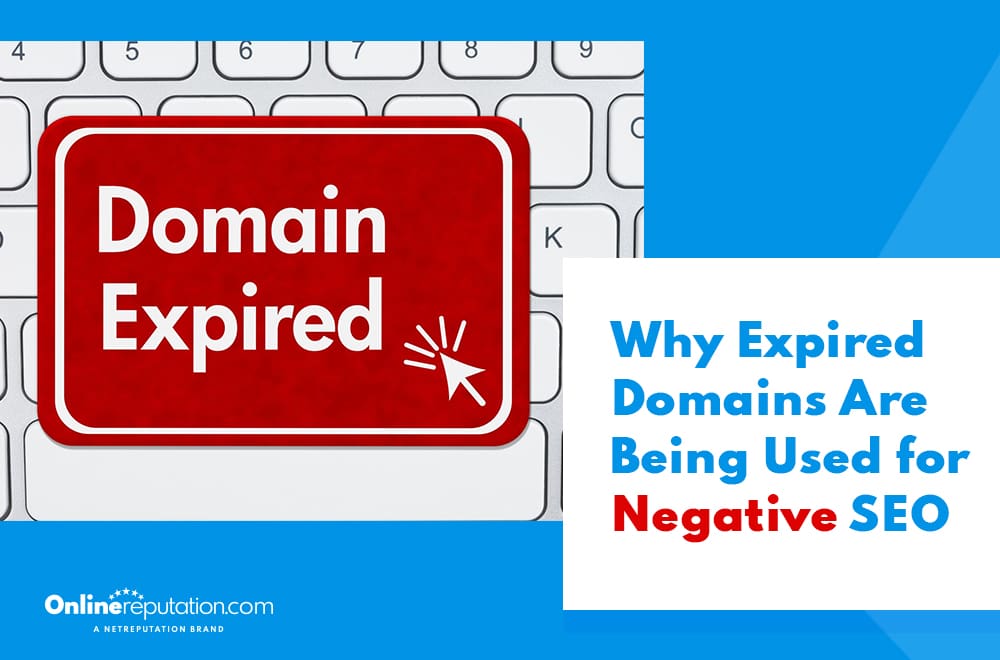
Every day, millions of domain names expire. Some previous registrants forget to renew them, while others intentionally drop them due to strategic decisions or business closures. Many expired domains still retain significant history, including valuable backlinks, steady traffic, or strong domain authority. That history makes these domains highly valuable to domain investors and businesses seeking to leverage existing SEO benefits—but it also attracts those who use them for negative SEO tactics.
Understanding how expired domains work, how people misuse them, and how you can protect your site is essential for anyone managing a website or involved in digital marketing today.
OnlineReputation.com provides information and services to help you protect your digital presence. Get started with a free online reputation analysis here and learn about our SEO services here.
What Are Expired Domains?
Expired domains are domain names once registered but not renewed by the previous registrant before their expiration date. After passing through the expiration process, these domains become available for public registration again. This process involves several stages:
- Grace period: Lasting 30–45 days, this phase allows the previous registrant to renew the domain without losing ownership.
- Redemption phase: After the grace period, the domain enters the redemption phase, where the owner can still reclaim it but often must pay additional fees.
- Pending delete: The final stage before the domain is released to the public for new registration. This phase usually lasts about five days.
At the end of this process, anyone can buy expired domains through domain registrars like GoDaddy, Namecheap, or specialized services. Tools such as DomCop, ExpiredDomains.net, or the Wayback Machine help verify a domain’s history, backlinks, and past content before purchase.
Why Are Expired Domains Valuable?
Even when a website is inactive, its backlinks, traffic history, and reputation may remain in search engine databases. This residual value gives expired domains considerable SEO advantages, making them appealing to various groups:
- Domain investors: These individuals or companies purchase expired domains with desirable traits, such as short domain lengths, clean backlink profiles, or popular domain extensions (e.g., .com, .org, .net, or new gTLDs). They often resell these domains for profit in the aftermarket.
- Marketers and businesses: Many register expired domain names that already have backlinks to boost the authority of new websites or enhance existing marketing campaigns.
- Developers and entrepreneurs: Some repurpose expired domains for new projects, create redirects, or build niche websites quickly using the existing SEO value.
However, the same value that makes these domains desirable can also lead to malicious use in negative SEO.
How Do People Use Expired Domains for Negative SEO?
Negative SEO involves tactics designed to harm a competitor’s search engine optimization efforts. Expired domains serve as one of the easiest and most common tools due to their built-in authority and backlink profiles.
1. Redirecting Expired Domains to Competitors
Attackers purchase expired domains with strong backlink profiles and set up 301 redirects pointing to a competitor’s site. While redirects sometimes pass authority legitimately, attackers flood the target with irrelevant or spammy link signals. Over time, this degrades the competitor’s search engine rankings and damages their online reputation.
2. Building Spammy Backlinks
Some repopulate expired domains with low-quality websites filled with spammy content, keyword stuffing, or link farms. These sites link out to a target site, making it appear suspicious to Google’s algorithms. This increases the risk of penalties or ranking drops for the victim.
3. Creating Fake or Malicious Websites
Certain attackers utilize expired domains to establish fake websites that disseminate misleading content, malware, or malicious links. Visitors may be misled by poor-quality information, while search engines may interpret these backlinks as part of the target’s network, harming credibility and trustworthiness.
4. Black Hat SEO Tactics
Black hat SEO practitioners combine expired domains with automated tools to generate keyword-stuffed pages, fake blogs, and extensive link farms. Their goal is to manipulate search engine rankings unfairly and disrupt competitors’ organic search results.
Why Do Expired Domains Attract Negative SEO?
The short answer: they already carry weight in the search ecosystem.
- Backlink history: Search engines may still consider old backlinks pointing to the expired domain, thereby retaining residual authority.
- Domain authority: Established metrics and domain age make expired domains look stronger than brand-new domains.
- Traffic patterns: Some users continue to visit old domains out of habit or through outdated links, thereby maintaining some visibility.
This combination of authority, history, and existing traffic makes attackers prefer expired domains over starting from scratch with new domains.
How to Protect Your Site From Negative SEO Involving Expired Domains
Monitor Your Backlinks Regularly
Utilize backlink analysis tools such as Ahrefs, SEMrush, Moz, or Google Search Console to monitor your backlink profile. Look for sudden spikes in low-quality or suspicious links from recently dropped or expired domains.
Disavow Suspicious Links Promptly
If you find harmful backlinks from expired domains, use Google’s Disavow Tool to tell search engines to ignore these links when evaluating your site’s authority.
Verify Domain History Before Buying
If you plan to buy expired domains for your use, always verify thoroughly. Use tools like the Wayback Machine to view past content and backlink analysis services to check for spammy or penalized histories. Avoid domains with blocked or suspicious backgrounds to protect your SEO.
Keep Your Website and Accounts Secure
Negative SEO can target weak points in your site’s security. Protect your accounts with strong, unique passwords, enable two-factor authentication, and regularly update your CMS, plugins, and hosting environment to patch vulnerabilities.
Plan for Regular SEO Audits
Schedule regular SEO audits to assess your site’s health and ensure the accuracy of its backlink profile. This helps you detect and respond to negative SEO attacks early.
What To Do If You’re a Victim of Negative SEO
- Gather Evidence: Document unusual traffic patterns, spammy backlinks, and suspicious activity. Take screenshots and keep detailed records.
- Report to Google: Use Google Search Console’s Spam Report form to notify Google of the attack.
- Contact SEO Professionals: Engage SEO experts or agencies specializing in negative SEO recovery to help devise a remediation plan.
- Consider Seeking Legal or Security Help: In severe cases, consult with legal counsel or cybersecurity professionals for additional assistance.
Conclusion
Expired domains are not inherently bad. Many businesses, domain investors, and marketers use them legitimately to build websites, expand reach, or add significant value to digital strategies. However, attackers can turn expired domains into powerful tools for negative SEO.
By understanding how expired domains work, verifying domain histories before purchase, closely monitoring your backlink profile, and taking proactive security measures, you can mitigate the risks associated with expired domains and protect your online reputation.
If you want to grab expired domains for business or investment, use reliable tools and services that provide accurate domain metrics, verification, and access to comprehensive expired domain lists covering various TLDs and gTLDs. This foundation helps you make informed decisions and build a strong presence in the competitive domain market, whether you seek a specific domain or want to bid on valuable expired domains in sales or auctions. Free tools and examples for review also assist in choosing the best domain when claiming and registering your next domain.
You might also like
What Is Radaris Used For? Explaining the People Search Website
Every day, millions of domain names expire. Some previous registrants forget to renew them, while others intentionally drop them due …

